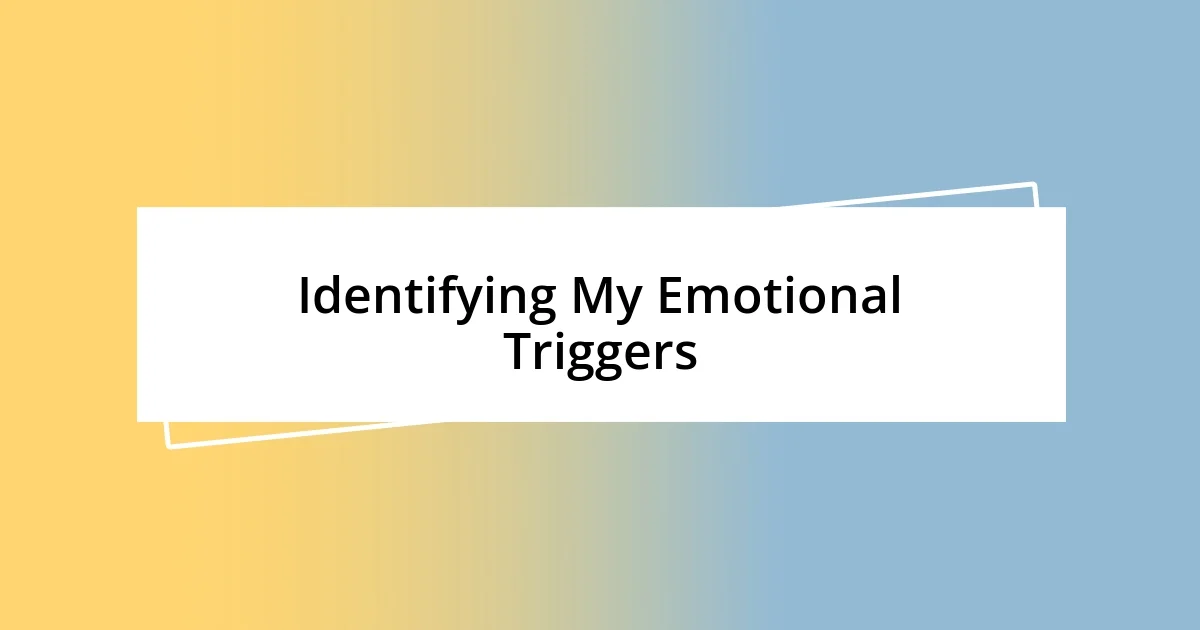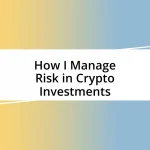Key takeaways:
- Recognizing emotional triggers and journaling helped transform impulsive trading decisions into more thoughtful responses based on a defined strategy.
- Developing a comprehensive trading plan provided a structured approach to trading, reducing the influence of emotions like fear and greed.
- Building a support network and finding a mentor offered valuable insights and accountability, easing the emotional burden of trading.

Understanding Emotional Trading
Emotional trading is a common pitfall for many investors, especially in the unpredictable world of crypto. I found myself swept up in the excitement of price surges and the dread of sudden drops, where my decisions often felt driven by fear or greed rather than logic. Have you ever experienced that rush of adrenaline when a trade goes well, only to be faced with crippling anxiety when the market moves against you?
Reflecting on my experiences, I realized that emotional trading often stems from a lack of a solid strategy. Without a plan, it’s easy to let emotions take the wheel, leading to impulsive decisions that can wipe out gains. I remember a time when a looming negative trend had me selling off my assets prematurely, simply out of panic; that was a lesson I won’t soon forget.
Understanding that emotions can cloud judgment is crucial in trading. I started developing mindfulness techniques to recognize my emotional triggers before they led me astray. It’s about asking myself: am I reacting to the market, or am I responding based on my predefined strategy? A clearer mind helps in making decisions that align with my overall investment goals rather than fleeting emotions.

Identifying My Emotional Triggers
Identifying my emotional triggers was a game-changer in my trading journey. I found that certain situations, like witnessing sudden price drops or hearing news about regulatory changes, would prompt intense feelings of anxiety or urgency. It was almost as if my body had a preset response, and I had to learn to pause and assess whether my feelings were justified or just a knee-jerk reaction to the market’s volatility.
One specific instance that stands out was when I noticed my heart racing every time I checked my portfolio after a major announcement. That fear of missing out on gains or getting stuck with losses would push me to make hasty trades. Recognizing this pattern allowed me to take a step back; now, I often remind myself to wait and analyze rather than react. It’s a vital practice that transforms trading from a frantic sprint into a more thoughtful and controlled process.
Often, I found that journaling my thoughts during trading sessions helped me pinpoint these emotional triggers. Writing down my feelings and the circumstances surrounding them revealed a pattern of emotional decisions that I had been unaware of. This self-awareness was transformative, as it empowered me to differentiate between rational strategies and emotional impulses when trading.
| Emotional Trigger | Response |
|---|---|
| Sudden Price Drop | Urgent panic to sell |
| Positive News | Excitement to buy more |
| Market Rumors | Feelings of insecurity |
| Watching Other Traders | Fear of missing out (FOMO) |

Developing a Trading Plan
Once I recognized the chaos emotional trading was creating in my life, I knew I had to create a trading plan to serve as my roadmap. This plan became my anchor in volatile waters, reminding me of my goals and strategies regardless of market turbulence. I remember sitting down one weekend, coffee in hand, and mapping out my plan; it was liberating to have guidelines I could follow, resisting the pull of impulsive decisions that used to plague my trading practices.
A well-crafted trading plan should include these essential elements:
- Clear Entry and Exit Points: Define specific price levels where you’ll buy and sell.
- Risk Management Strategy: Establish how much of your portfolio you are willing to risk on any one trade.
- Consistent Timeframe: Decide how long you will hold each trade, whether short-term or long-term.
- Set Goals: Set realistic profit targets and loss limits based on your trading style.
- Review Schedule: Include regular reviews to assess your strategy and make necessary adjustments.
By having these components in place, I felt a sense of control that allowed me to engage with the market on my terms rather than on the erratic whims of fear or excitement. Each moment spent refining my trading plan reinforced my commitment to disciplined trading.

Practicing Mindfulness Techniques
Mindfulness techniques became essential tools in my journey to overcome emotional trading. During particularly volatile trading days, I started practicing deep breathing exercises. Taking a few moments to inhale deeply and exhale slowly helped me calm my racing thoughts, enabling me to approach my decisions with more clarity. I often asked myself, “What is the most rational choice I can make right now?” This simple question shifted my mindset, guiding me toward thoughtful actions instead of emotional reactions.
I’ve also found that integrating meditation into my daily routine has been incredibly grounding. Setting aside just ten minutes each morning to focus on my breath and clear my mind has made a noticeable difference. This practice not only centers my thoughts but also reminds me to approach trading with patience and composure. I recall a particularly challenging week when the market dipped unexpectedly; instead of succumbing to panic, I utilized my meditation techniques to help maintain my perspective. It was like having an emotional buffer, allowing me to see the situation more objectively.
Gratitude journaling emerged as another powerful mindfulness technique in my trading toolkit. Each evening, I would write down three positive aspects of the day, especially focusing on lessons learned from my trades. This practice cultivated a mindset of appreciation rather than frustration, reminding me that mistakes are part of the growth process. I remember one night reflecting on a poor trading decision; rather than beating myself up, I acknowledged it as an opportunity to learn and improve. How often do we forget to appreciate the journey we’re on? By practicing mindfulness daily, I cultivated resilience and clarity that significantly elevated my trading experience.

Setting Realistic Goals
Setting realistic goals in trading is vital for emotional balance. When I first started, I remember setting sky-high profit targets that felt exhilarating but were rarely achievable. Each time I fell short, the disappointment only fueled my emotional trading. Have you ever felt that overwhelming expectation weigh you down? I certainly did, and it took time to understand that small, manageable goals not only kept me motivated but also built my confidence.
One day, I decided to flip my perspective entirely. Instead of aiming for a 50% return in a month, I set a goal to increase my portfolio by just 5% each week. At first, it seemed almost trivial, but as I experienced consistent success, my mindset began to shift. I felt more grounded and less tempted to chase wild trades, knowing I was making tangible progress, no matter how modest. Isn’t it interesting how the small wins can lead to a more significant transformation?
Moreover, I learned to incorporate personal factors into my trading goals. What fits my lifestyle? How much time can I dedicate to research and screen time? Answering these questions helped me align my trading ambitions with my daily routine. Keeping my goals in line with my life allowed me to trade with intention and clarity, rather than chaos. Establishing clear and realistic goals became the cornerstone of my success and peace of mind in the tumultuous world of crypto trading.

Tracking and Analyzing Trades
Tracking my trades transformed the way I engaged with the market. Initially, I kept a simple spreadsheet, but over time, I realized that documenting decisions, emotions, and the outcomes behind each trade was key to understanding my behavior. It’s a bit like keeping a journal—did you ever notice how revisiting your thoughts can clarify patterns you didn’t recognize before? I found the process incredibly enlightening.
Analyzing my trades became a reflective practice. Each week, I set aside a few hours to review my trades, focusing not just on profits and losses, but also on the emotional state I was in at the time. I distinctly remember a week where I lost on three consecutive trades, and upon reflection, I recognized I had bypassed my trading rules out of frustration. This awareness helped me tighten my strategy and ultimately provided a more disciplined approach moving forward.
Moreover, I discovered the value of visualizing my performance through charts and graphs. Seeing data illustrated over time gave me insights into trends I might have overlooked. I once plotted my success rate against my emotional highs and lows, and the correlation was staggering. Does tracking trades help uncover your trading patterns? In my case, it opened up a pathway to emotional resilience and informed decision-making that I had been searching for.

Building a Support Network
Building a support network was pivotal for me in overcoming the emotional rollercoaster of trading. Initially, I felt isolated, thinking I had to navigate this intense journey alone. But then, I joined a local trading group. Connecting with like-minded individuals who shared their experiences and setbacks was incredibly freeing. Have you ever had that moment where you realize others face the same challenges? It’s oddly comforting, and it reinforced my commitment to my trading strategy.
As I opened up about my struggles with emotional trading, members were always eager to share their insights. I remember one particular discussion where someone mentioned how they coped during downturns by leaning on their support network. That resonated with me. It made sense! Instead of succumbing to panic, I started reaching out during stressful times, which became a valuable lifeline. Establishing this kind of support helped me feel less alone and brought a sense of accountability that kept me in check.
Furthermore, nurturing relationships with those who have more experience proved to be a game changer. I found a mentor who guided me through the murky waters of emotional trading. His wisdom taught me that it’s okay to lean on others for support. Have you ever thought about the untapped wisdom in your network? The conversations I had not only deepened my understanding of trading but also emphasized the emotional aspects involved. This network became my safety net, reminding me that I didn’t have to rely solely on my judgment in volatile markets.














